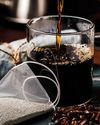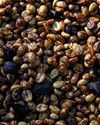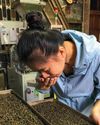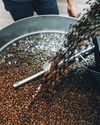
All the old tales about white tea being picked by virgins for the emperors of China in ancient times are frilly myths. White tea was created in Fujian, southeastern China, in the late 18th century, making it a baby compared with its venerable siblings like green or Pu'er tea.
Tea type is defined not by the plant variety but by the method of processing leaves. The recipe for making white tea is simple: dry the fresh leaves. But as always with tea, there is a world of complexity within that simplicity.
As soon as the leaf is picked it begins to wilt, releasing compounds that mix with enzymes and air and commence oxidation, transforming the fresh taste of the leaves into stronger and sweeter brews. In white tea, the oxidation is stopped by drying the tea completely. The skill of the producer is to regulate this drying process: slow enough to allow for some warming oxidation but fast enough to maintain the desired freshness.
Traditionally, the leaves are piled on bamboo mats – having taken into account temperature and humidity – and these are moved around over a drying session (20-60 hours) to achieve the optimal taste. At least some of this time should be spent under full-spectrum sunlight, which further enhances flavor. The dried tea should be left for a week to air out its grassy aromas, then baked at low temperatures. Top-end teas are then charcoal-baked for hours to enhance the warming nature and sticky texture of the resulting brews.
This story is from the Issue 41 edition of Caffeine.
Start your 7-day Magzter GOLD free trial to access thousands of curated premium stories, and 8,500+ magazines and newspapers.
Already a subscriber ? Sign In
This story is from the Issue 41 edition of Caffeine.
Start your 7-day Magzter GOLD free trial to access thousands of curated premium stories, and 8,500+ magazines and newspapers.
Already a subscriber? Sign In

The Future Of Decaf?
A US company claims its pouch extracts caffeine without harming flavour

Great Coffee Shouldn't Cost The Earth
Caffeine’s editor-at-large Tim Ridley explains how to lower the environmental impact of your coffee-drinking habit

What The F**k...Is Honey Processing?
Apart from natural and washed coffees sits a whole other category, as Sierra Wen Xin Yeo explains

The grind
SEASONAL COFFEE

Tea with purpose
Michelle and Rob Comins explain how tea can be a force for good

Ten years on
We celebrate the London Coffee Festival’s first decade with a look at its successes

Chocolate and espresso pavlova with fennel roasted grapes
This year I’m giving coffee centre stage on the Christmas dessert table. I firmly believe coffee shouldn’t just be an afterthought to accompany dessert, it should be the dessert – but aside from that, it just makes sense.

Bitter Barista
Latte art competitions have been milking it for too long – they used to be fun, but now their focus on the wrong things is harming barista skills, says our cantankerous columnist

What The F**k ...Is The Maillard Reaction?
It’s just one of the elements you need to know about if you’re going to roast coffee successfully, as Edgaras Juška explains

Work Wonders
Coffee gets people through the working day. So it stands to reason that better coffee produces better work – and in some places the two are in perfect harmony, says Phil Wain